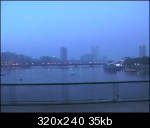
edit this image:
First, I duplicated the image from the menu Image / Duplicate. This
to always have in view the original image is not edited. * (You can also avoid this step, I made this just for my convenience) *
dominant blue : I used the Match Color Image Settings menu. * (There are also other techniques, chosen based on the image to be corrected)
* Brightness adjustment : Lights and shadows in the Image menu, Adjustments, converted Subject advanced. With this action is gone ... even the slight haze in rhyme * (convert to Smart Object means being able to intervene at any time, for example a filter applied several steps before. This feature was introduced by whisker version of Photoshop CS3) * Straighten image
: Before I unlocked the background layer (double click on it) I took as a reference of 'horizontal and vertical high-rise bridge over the water and the far right, using the guidelines. Approaching the Move tool pointer near a corner of the image I have rotated the useful part I selected and cropped with the Crop tool from the Image menu.
At this point was still tilted and deformed the safety rail just above the asphalt down, perhaps due to a weak or deformed due to a side angle shot. I however rectified with Altera menu Edit / Transform.
* Excerpts with Levels, Curves and merged all the layers on the palette to a new level: Shift + Ctrl + Alt + EHO duplicate the layer you just created and to counter the image I used the High Pass filter by Filter / Other, with a radius very low: 1.5 pix. then changing the blending mode to Overlay.

